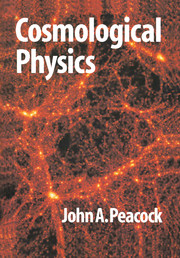Book contents
- Frontmatter
- Contents
- Preface
- Part 1 Gravitation and relativity
- Part 2 Classical cosmology
- Part 3 Basics of quantum fields
- Part 4 The early universe
- Part 5 Observational cosmology
- Part 6 Galaxy formation and clustering
- 15 Dynamics of structure formation
- 16 Cosmological density fields
- 17 Galaxy formation
- 18 Cosmic background fluctuations
- Hints for solution of the problems
- Bibliography and references
- Useful numbers and formulae
- Index
17 - Galaxy formation
Published online by Cambridge University Press: 05 June 2012
- Frontmatter
- Contents
- Preface
- Part 1 Gravitation and relativity
- Part 2 Classical cosmology
- Part 3 Basics of quantum fields
- Part 4 The early universe
- Part 5 Observational cosmology
- Part 6 Galaxy formation and clustering
- 15 Dynamics of structure formation
- 16 Cosmological density fields
- 17 Galaxy formation
- 18 Cosmic background fluctuations
- Hints for solution of the problems
- Bibliography and references
- Useful numbers and formulae
- Index
Summary
The sequence of galaxy formation
The discussion of galaxy evolution in chapter 13 raised many basic questions about the process of galaxy formation: did bulges form first, and did they accrete disks later? What is the importance of galaxy mergers? What sets the form of the galaxy luminosity function? In addition, we have seen in chapters 12 and 16 that an Ω = 1 universe requires galaxy formation to be biased in favour of high-density environments; how could such a bias have arisen? The purpose of this chapter is to present some of the theoretical tools with which these questions may be tackled. We start with a simple overview of two contrasting ways in which collapsed objects like galaxies could form.
dissipationless collapse What will be the final state of an object that breaks away from the background and undergoes gravitational collapse? If the matter of the object is collisionless (either purely dark matter, or stars), this is a relatively well-posed problem, which should be capable of a clear solution.
The analytical approach has concentrated on gravitational thermodynamics, and sought an equilibrium solution. This has turned out to be a subtle and paradoxical problem, whose main analysis goes back to a classic paper by Lynden-Bell (1967). Imagine initially that the self-gravitating body consists of gas, so that it is reasonable to look for an equilibrium solution in the form of a configuration of constant temperature.
- Type
- Chapter
- Information
- Cosmological Physics , pp. 553 - 586Publisher: Cambridge University PressPrint publication year: 1998



